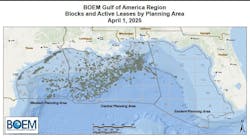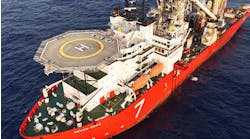Offshore staff
WASHINGTON, D.C. – A new study from Energy & Industrial Advisory Partners (EIAP), commissioned by the National Ocean Industries Association (NOIA), details the diversity of companies and multitude of jobs involved in the exploration, development, and production of American offshore oil and natural gas.
The study, The Gulf of Mexico Oil & Gas Project Lifecycle: Building an American Energy & Economic Anchor, shows how the 30-year lifecycle of each offshore oil and gas project serves as an economic engine for American investment and thousands of high paying jobs.
NOIA President Erik Milito said: “The multitude and diversity of US offshore oil and gas jobs begin well before any lease sale. These jobs, which are high paying and accessible, lift countless Gulf Coast communities and support the investment footprint of businesses in every single US state. The Gulf of Mexico has transformed into a national strategic infrastructure asset, and we must make every effort to sustain it through a predictable regulatory system that includes regularly scheduled lease sales and continued permitting.
“While the global economy is transitioning to a lower carbon future, the offshore oil and gas industry is playing a key role through investing in low carbon technologies and developing oil and gas projects that are recognized as providing the lowest carbon barrels. Government policy should continue to encourage investment in the US Gulf of Mexico energy sector to secure the tremendous energy, climate, and national security benefits for American citizens, as well as help avert potential inflationary risks associated with high energy costs.
“Instead of trying to fix with an unforced error by turning to foreign, higher-emitting sources of energy and asking OPEC to increase oil production, President Biden should fulfill his legal obligation to schedule and hold offshore oil and gas lease sales and abandon the shortsighted leasing pause. As long as Americans depend upon oil and gas for modern life, it must come from somewhere and it is clearly better to get oil and gas here at home than from a foreign state with weak environmental safeguards.”
Key findings
Importantly, jobs and spending for offshore oil and gas projects begin well before a lease is signed with the federal government and continue through the leasing stage all the way through decommissioning. Not only does the continued pause of Gulf of Mexico lease sales remove a critical revenue stream for the federal government through lease bids, but it also puts high paying jobs and billions of dollars of investment at risk.
Geologists, geophysicists, computer scientists, petroleum engineers, accounting and finance professionals and economists are all needed during the pre-lease phase. These women and men play in an important role in reviewing and reprocessing existing seismic and well data, providing prospect identification and analysis, calculating lease valuations and more.
According to the report, more than 200 different types of jobs are directly involved in offshore oil and gas projects. The quality of employment in the US offshore oil and gas industry is well above the national average. With average annual wages of $69,650, US offshore oil and gas wages are 29% higher than the national average. Many of the jobs identified in the report bring in wages significantly higher than that.
Deepwater project
For the model deepwater project, estimated total lifetime spending is just over $8.8 billion, with $3 billion in total direct wages. Average annual spending is projected at nearly $295 million. Total annual supported employment is projected to average nearly 3,640 jobs. During the most active years, employment impacts peak at nearly 14,450 jobs.
Shallow-water project
For the model shallow water project, estimated total lifetime spending is over $1.3 billion, with $485 million in total direct wages. Average annual spending is projected at $45 million. Total annual supported employment is projected to average nearly 615 jobs. During the most active years, employment impacts peak at nearly 1,800 jobs.
The Gulf of Mexico impact
The Gulf of Mexico in its entirety, including both shallow water and deepwater projects, supported more than 345,000 jobs in 2019, according to the report. This number is projected to increase to more than 400,000 jobs if the right government policies are in place.
The Gulf of Mexico oil and gas industry is also the primary funding mechanism for the Land & Water Conservation Fund, proving vital funding for constructing and renovating urban parks and for maintaining and renovating our treasured national parks. The industry also provides key funding for coastal resilience throughout the Gulf Coast. All this funding is adversely impacted by the leasing pause.
08/12/2021



